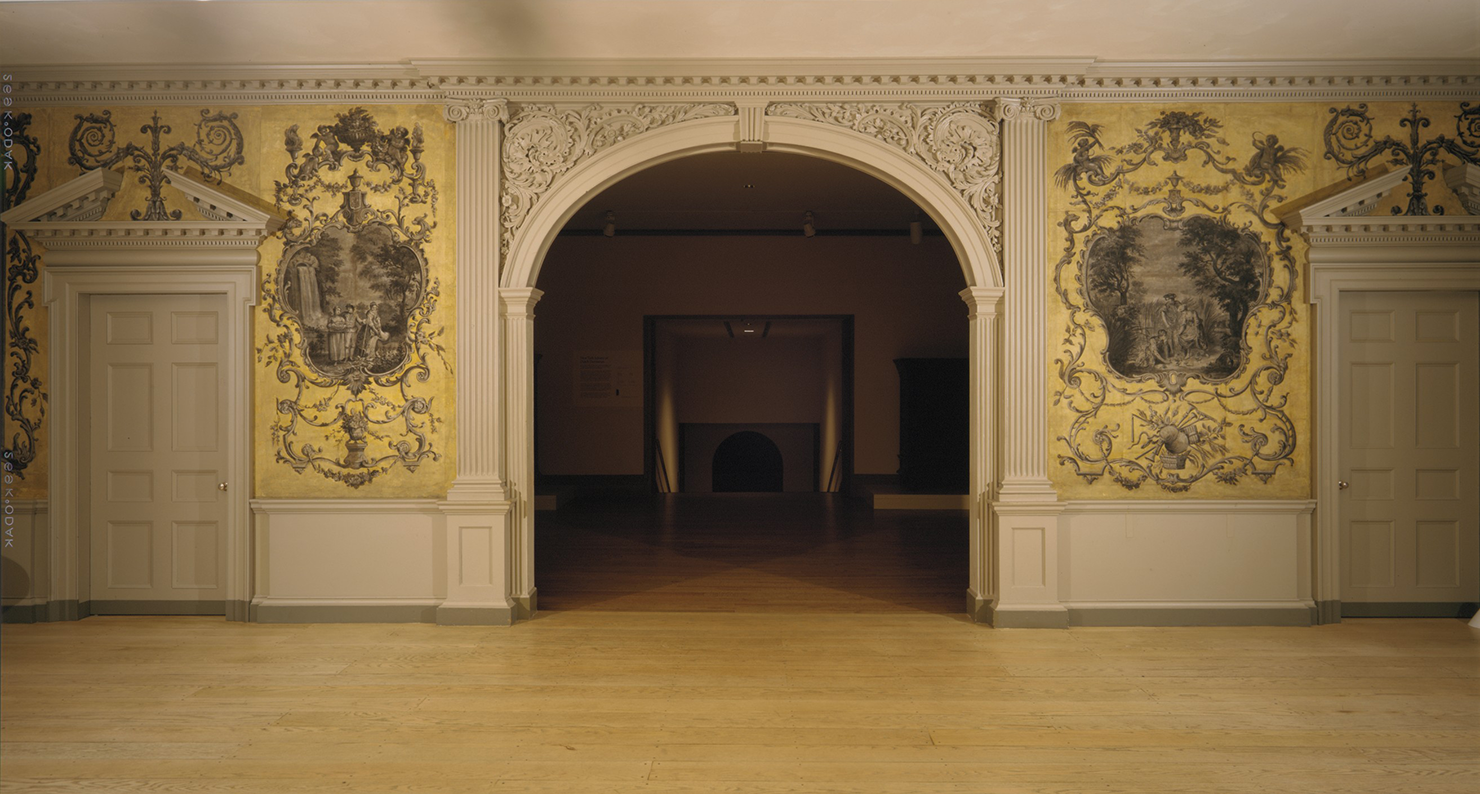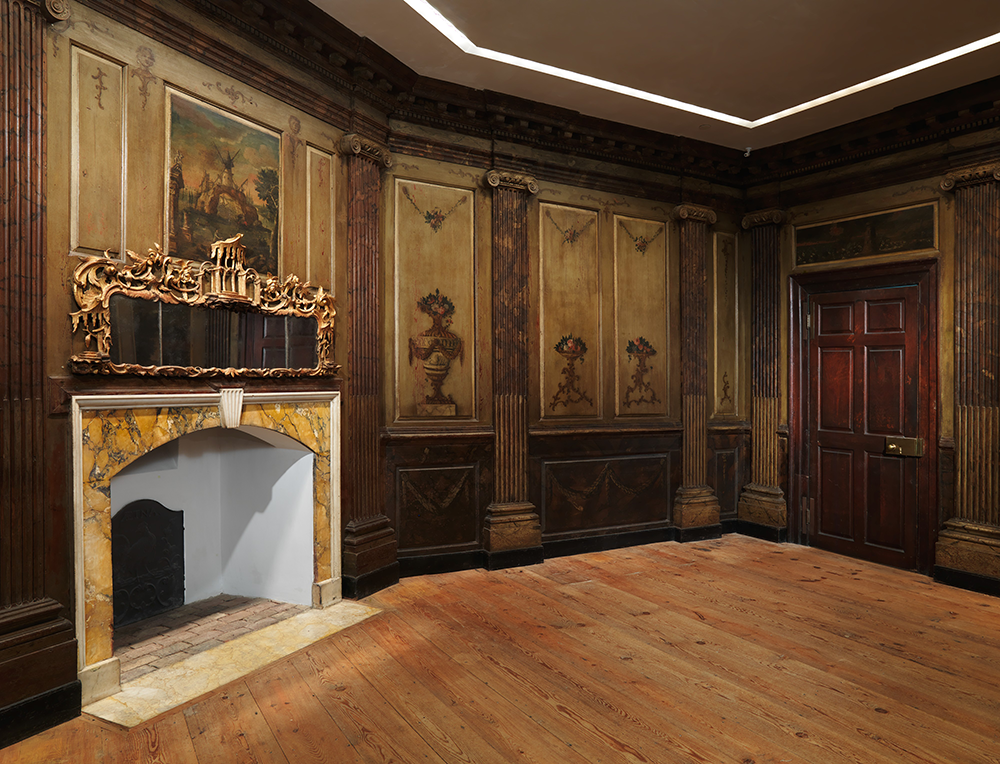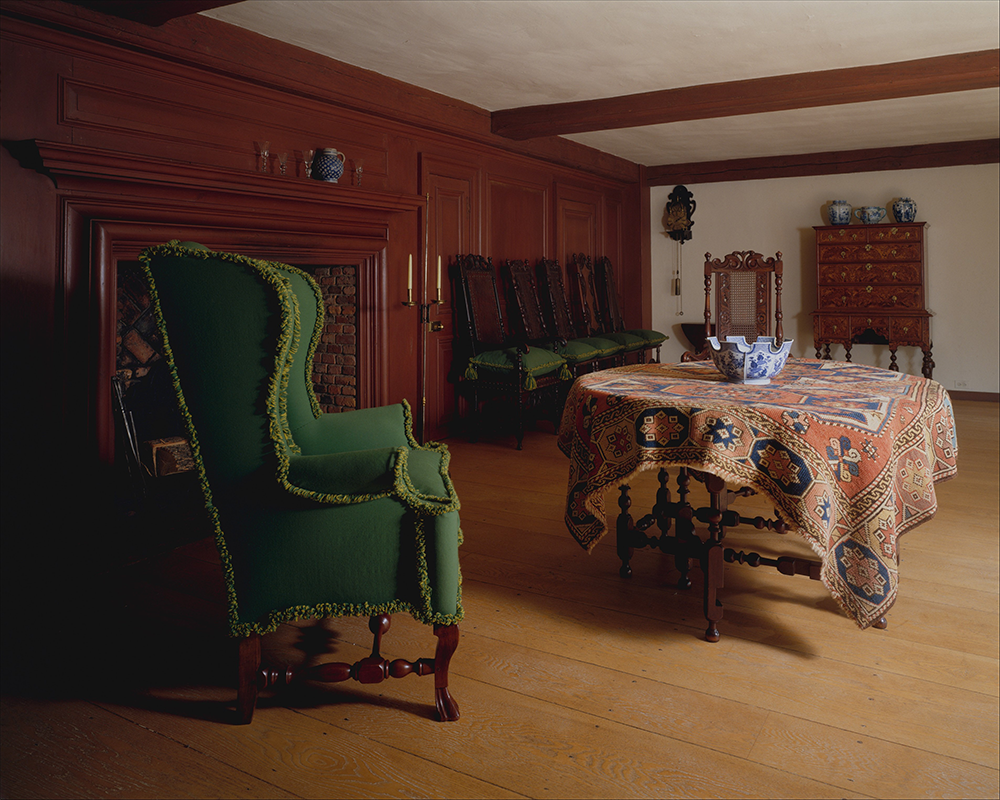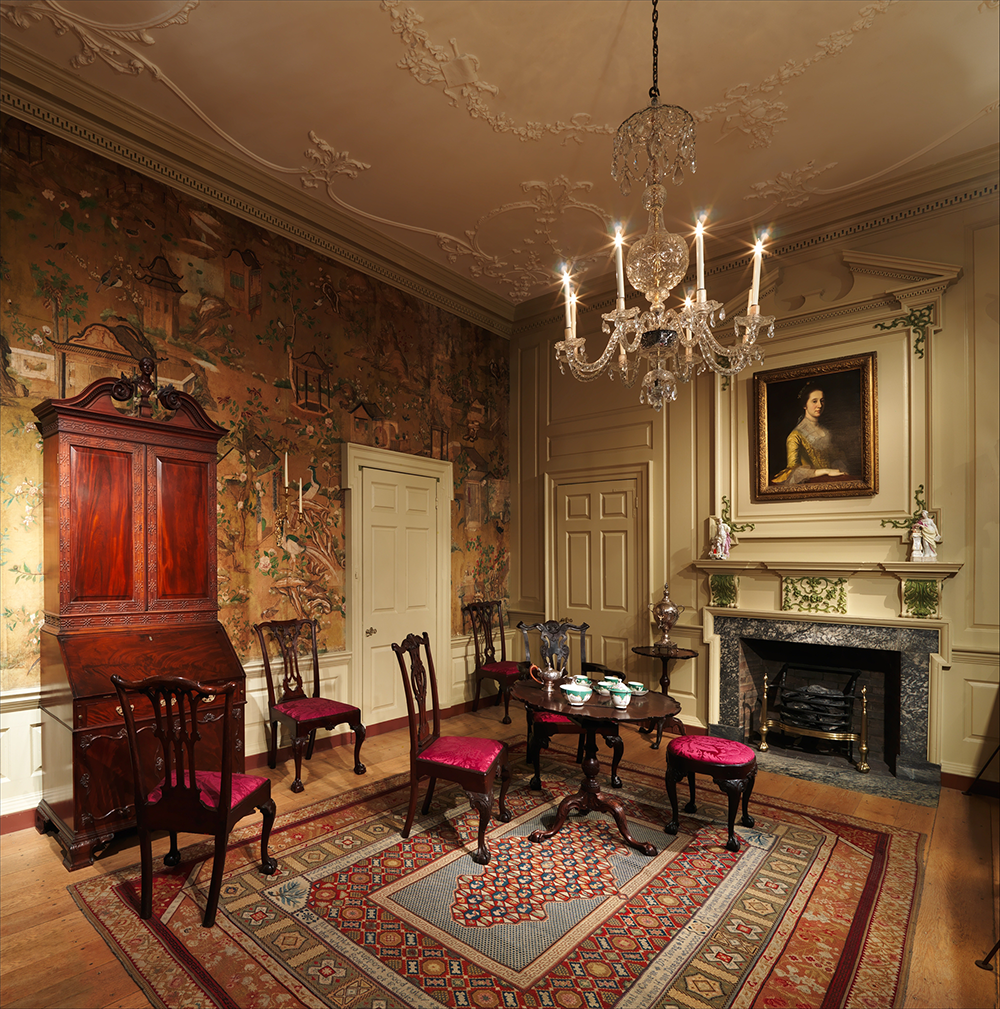
Door from the Great Hall of Van Rensselaer Manor House, Albany, New York, 1765–69. The Metropolitan Museum of Art, Gift of the Trustees of Sigma Phi Society of Williams College, 1931.
There are two ways to access the Metropolitan Museum of Art’s American period rooms, situated behind the 1823 Branch Bank facade in the Charles Englehard Court, a space bright with winsome marbles and burbling with fountain sounds. One may enter via either medieval Europe or the patio of another of the museum’s great indoor edifices, the Temple of Dendur. On a recent visit, I took the latter route and, upon entering the American sector, immediately mistook a framed reproduction in the gift shop for “real” art. My prolonged respectful gazing was, mercifully, unnoticed. As I moved awkwardly on, I happened to glance at another item of nonart, a nearby plaque explaining the American Wing’s “Campaign for the 21st Century.” The sign announces:
The American Wing offers the Metropolitan Museum’s principal display of American art made before 1920. Originally opened in 1924, the American Wing has recently undergone a comprehensive renovation to best present its collections for twenty-first century audiences. Conducted in three phases over a decade, the Wing has been modernized and reconceived to provide a more logical and aesthetically pleasing path along which to travel through American art and history.
Beside this notice is a list of generous donors of “Gifts of $1 million and above as of May 15, 2015.” By my count, there are approximately thirty names on the list, including the City of New York.
The phrases “to best present its collections for twenty-first century audiences” and “modernized and reconceived” stick with me. The period rooms—a sort of hybrid, heteroclite house within the larger house of the museum—are the center of the American Wing, and the plaque recommends their recent modernization and new orderliness in particular. There is, for example, a newish glass elevator ready to whisk visitors between floors. Numerous touch screens offer animations and informative text. The “house” itself, last redone in 2009, now combines twenty-odd historical rooms, from 1680 to 1915, with parlors harvested from Southern plantations alongside paneled rooms from ancient New England homesteads, not to mention a swank Frank Lloyd Wright parlor. It is an exceedingly complex document, the creation of various unusually prosperous American ancestors working in unknowing collaboration with the museum’s staff and trustees, a ship of Theseus if ever there was one. It also seems to be one of the least popular parts of the museum. Often, one or more of the floors is closed to public view due to, as a guard told me, lack of foot traffic, persistent ceiling leaks, or perhaps a combination of the two. One hopes the wing’s benefactors may help out with ceiling continence soon.
The Met’s American period rooms first opened to the public in 1924. According to Robert W. de Forest, then the museum’s president, the purpose of this chronologically tidy feat of spatial reproduction—a massive diorama into which the public could stroll from century to century, moving backward through time from a decadent nineteenth-century ground floor to a seventeenth-century attic outfitted with low ceilings and heavy wood—was “to test out the question of whether American domestic art was worthy of a place in an art museum, and to test it out not theoretically but visually.” Though an experiment, it was intended to be permanent: the first major installation of decorative arts and furniture of Colonial and early Federal America in an urban museum, in a purpose-built wing containing rooms complete with original paneling, ceilings, beams, staged lighting, and painted skies visible beyond built-in windows. (In Europe, period rooms had been a curatorial modus operandi since at least 1873, when Stockholm’s Nordiska Museet opened a number of them.) The Met’s period rooms were, in one sense, a response to the seductive Continental dawning of Art Deco in the 1910s from the matrix of Cubist and Fauvist art. Deco forms were bright, internationalist, mechanically reproducible, and potentially highly commercial. The 1925 International Exhibition of Modern Decorative and Industrial Arts in Paris proved the movement’s success, though it was not attended by a delegation from the U.S. The rooms of the new 1924 American Wing, meanwhile, expressed the tastes of a tightly knit upper class and increasingly nativist milieu, advertising these interests to a broader public as didactic content. Concerned with a selective history that links moneyed Dutch and Anglophone ancestors of Protestant faith, the rooms detail a conservative, antimodern vision of the U.S., with a pursuant aristocracy. The rooms elided the influence of late nineteenth-century waves of immigration from Southern and Eastern Europe and the Middle East, along with the increasing importance of German, Jewish, and Catholic culture within the U.S., as well as Victorian innovations in design. They presented American culture as an early nineteenth-century fait accompli, in which rococo revival and neoclassical styles reigned supreme and home decor was all but exclusively authored by males. At the time of the 1924 opening, the Met’s period-room galleries seemed to proclaim that great innovation and beauty in American furnishings commenced just before 1700 and ceased around 1811. The museum would not begin to install later nineteenth- and early twentieth-century rooms until 1982.
The wing was the personal project of three men: de Forest; Henry Watson Kent, an influential librarian and administrator; and R.T.H. Halsey, an Anglophile stockbroker, collector, chairman of the museum’s Committee on Decorative Arts, and trustee. The three gentlemen worked autonomously, bypassing bureaucracy. De Forest personally purchased the 1823 facade of the former Assay Office building from Wall Street in 1915, and other acquisitions arrived through familiar channels, such as de Forest’s wife, Emily, who gave the Met its first period-room element, a Long Island fireplace, in 1910. It was by no means a foregone conclusion that American decorative arts were canonically significant, despite the nation’s growing wealth and World War I victory. This afforded the undertaking a certain interventionist quality, even as the results now appear elite in the extreme. These rooms also had the function—perhaps not even secondarily—of increasing the value of the objects they contained. Many of the people affiliated with the Met were themselves Colonial-revival enthusiasts who stood to gain from the boom in antiques and Americana during the 1910s and 1920s.

The value and rarity of these objects cut both ways: the narrowness of the interests of the engineers of the American Wing made their task all the more difficult. Even during the war, it was no simple matter to obtain desirable Colonial and early republican interiors. New England, for example, did not relinquish its wood paneling cheaply. In 1916 and 1917, one young curator, Durr Friedley, was dispatched below the Mason-Dixon to investigate estates facing foreclosure. (Friedley later turned down a more permanent job with the Met and pursued a career as a painter, hanging out with Gertrude Stein and other luminaries.) Historian Jeffrey Trask writes that the Old Dominion “ultimately served as the Metropolitan’s best resource for elite period rooms.” One is the painted Marmion Room, circa 1756, from the formerly slaveholding Marmion Plantation in Fredericksburg, Virginia, obtained in 1916 (presumably by Friedley). Found on the second floor of the Met’s American period-room section, this disconcerting and very yellow space sports dim wall paintings of garlanded vases, Romantic vistas replete with windmills and ruins, impish disembodied heads, and trompe l’oeil marble. New York Times art critic Roberta Smith described the room as “incalculably sweet” in a 2000 piece, but I find it drippy and weird. One 1916 description by architectural historian Frank Conger Baldwin claims that the paintings were a gift of gratitude from a Hessian mercenary who had been nursed back to health at the plantation. An elaborate gilded mirror with soggy rococo curlicues and a sunken central folly hangs over the otherwise empty room’s fireplace. The room was also apparently far more luxurious than the exterior of the original manor would have let on—for reasons that remain mysterious—lending it an additional air of unease that is difficult to diagnose. In her 1930 book Virginia Ghosts, Marguerite du Pont Lee records the legend of a “white lady,” a young girl who haunts the Marmion grounds, protecting the place and even attempting to shake hands with some astonished visitors.
But this is approaching a folk tale, and the Met’s rooms were created with far more rational, if not social engineering, ends in mind. Architect, professional home restorer, and Met curator Charles Over Cornelius had touted the “vitalizing influence of period group displays” in his article “The Museum and the Collector” in the inaugural issue of Antiques magazine from 1922. Cornelius’ dry prose unpacks the relationship between selection, arrangement, and connoisseurship of decorative works in a museum. It also provides a sociological anatomy of the collector.
Most collecting is done from one of three points of view—the aesthetic, the historical, or the utilitarian. The aesthetic point of view emphasizes the art content and quality of an object whatever its material or period; the historical attitude allows its historic import or interest to outweigh the measure of its artistic quality, while a utilitarian collector assembles objects of a decorative art for actual use, however carefully he chooses with discriminating care as to their artistic quality. All these viewpoints may be satisfied in the museum by a certain amount of period grouping.
In Cornelius’ account, the visitor to period arrangements is already a consumer of goods, taste, and history. The museum provides visual material that, while not itself available for sale, stimulates the broader market. Elsewhere in the magazine, an unsigned editorial describes “an intensified interest in places and objects of historical and antiquarian value” either connected to “stimulated national self-consciousness resulting from participation in the World War, or somehow a by-product of the Americanization movement”—that is, the initiatives designed to convert immigrants into Americans. This new interest resulted in art exhibits “in which relics, some valuable, some merely curious, some, perhaps, absurd, are coming to be a recognized part of community gatherings of all kinds.” Given the barely concealed venality of Cornelius’ imagined collector, the jump to imagining a chummy, tag-sale-loving “community” of collectors is startling. The anonymous editor’s use of the dog-whistle phrase “Americanization movement” suggests this community would be composed of individuals who, as late as 1922, believed that the rigorous assimilation of immigrants into so-called American culture was not merely important but dangerously incomplete. Enthusiasm for antiques was apparently thought to be a bulwark against degenerate hordes. Among those professing such views were the creators of the Met’s period rooms.

The two catalogues published by the museum to coincide with the opening of the American Wing did more overt ideological work. A Handbook of the American Wing was coauthored by Cornelius and Halsey; the latter was “nativist and anti-immigrant in affiliation and antimodern in his sympathies,” historian Neil Harris writes, adding a further wrinkle to the meaning of the period rooms. The second publication was also coauthored by Halsey, this time with his third wife, Elizabeth Tower: The Homes of Our Ancestors, as Shown in the American Wing of the Metropolitan Museum of Art of New York from the Beginnings of New England through the Early Days of the Republic, Exhibiting the Development of the Arts of Interior Architecture and House Decoration, the Arts of Cabinetmaking, Silversmithing, etc., Especial Emphasis Being Laid upon the Point That Our Early Craftsmen Evolved from the Fashions of the Old World a Style of Their Own; with an Account of the Social Conditions Surrounding the Life of the Original Owners of the Various Rooms. The interminable title matches the book’s bombastic insistence on the greatness of “the spirit in which those men who made the colonies and those who founded the republic lived their lives at home and superimposed urbanity upon the site of the primeval wilderness.”
Halsey’s image of the past was reactionary, to say the least. As he confided to de Forest in a personal letter, “We should endeavor to show in the rooms things which have class. The furnishings should be restrained and no semblance of crowding permitted”—the assumption being that those who might crowd in would bring with them the worst traits of unwanted, unfit, “un-American” groups. This celebration of ancestral homes took place less than half a year after the passage of the 1924 Immigration Act, signed into law on May 24 by President Calvin Coolidge (whose White House Halsey would decorate in 1925) in order to “limit the immigration of aliens into the United States, and for other purposes” by means of annual quotas of “two per centum of the number of foreign-born individuals of such nationality resident in continental United States as determined by the United States Census of 1890.” Much as the American Wing institutionalized an ideological experiment around American domestic culture and history, so this law made permanent those quotas set in place temporarily two years earlier. The restrictions of the 1924 act unpleasantly echo the aesthetic logic of the antiques collector, returning the nation by means of “informed” selection to a bygone time of supposed greater order and homogeneity. As recent books like Adam Cohen’s Imbeciles: The Supreme Court, American Eugenics, and the Sterilization of Carrie Buck and Thomas C. Leonard’s Illiberal Reformers: Race, Eugenics, and American Economics in the Progressive Era have shown, the federal government’s decision to turn to 1890 census data to create immigration legislation in the 1920s emerged from discriminatory eugenicist theories that emphasized the hereditary dangers of miscegenation as well as problems caused by “weak minded” members of the working class, who were bound to reproduce in excessive numbers. There was also the perceived danger of the spread of Communism. The ethnic and multinational makeup of the United States depicted in the 1890 census gave license to dramatic restrictions on immigration—helpfully for nativists, as the census all but neglected to admit the existence (and populations) of the continents of Africa and Asia, even as it closed the door to Southern and Eastern Europeans. So while Germany was given a quota of 51,227 and Great Britain was given a quota of 34,007, Italy received a quota of just 3,845. A colonial construct called “South West Africa (proposed mandate of Union of South Africa)” received the minimum quota of 100 persons—African Americans who came to the United States as slaves were considered irrelevant to the act. Other large nations receiving the minimum designation included India, China, and Persia.
The nativist shift that culminated in the 1924 act wasn’t limited to the hushed discourse of collectors of decorative things, of course. “Nordic Victory Is Seen in Drastic Restrictions” read a Los Angeles Times headline on April 13, 1924, citing the coming act as well as Madison Grant’s Passing of the Great Race, first published in 1916, with new editions in 1921 and 1923. Grant’s book outlined a three-tiered system by which whites might identify as “Mediterraneans,” “Alpines,” and “Nordics,” with the final category being the purest and superior designation. Grant warned against the corruption of American society by immigration from Southern and Eastern Europe, as well as from the growing economic empowerment of African Americans, whose migration north to industrialized cities disturbed his sense of natural order. He predicted a dissolution of the U.S. into a fragmented, corrupt nation of mongrels if absolute power were not maintained by Nordic whites, whom he somewhat creatively equated with individuals of English, Scottish, and Dutch descent. Grant’s theory of eugenics seemed to condone ethnically and economically motivated violence, such as the West Frankfort, Illinois, mob beating and arson attack carried out on August 5, 1920 against Italian immigrants, who were perceived by local members of the white working class to be colluding with the Mafia. The July 1924 Democratic National Convention in New York City, aka the “Klanbake,” saw an almost successful insurgency when Klan sympathizers rejected both an anti-Klan plank in the party’s platform and the nomination of Governor Alfred E. Smith of New York, a second-generation Irish American and Catholic. A year later, in August 1925, 25,000 Klansmen marched on Washington, DC, to demonstrate their white-robed numbers and fundamentalist determination.
Beyond serving as an inflammatory ideology, whiteness was a legal concept, as some regarded nation and race as synonyms. In 1925 an Oregon court heard testimony from anthropologist Franz Boas that “it would be utterly impossible to classify” Tatos O. Cartozian and other Armenians “as not belonging to the white race” and ruled in U.S. v. Cartozian that they were European “Alpines.” That same year, the state of Michigan successfully sued to revoke the U.S. citizenship of John Mohammad Ali, a traveling lecturer and wholesale importer born in India, arguing that race and nationality were inextricable. When Ali had become a naturalized citizen in 1921, “high caste” Hindus were considered “white” and therefore eligible for naturalization. But the 1923 case U.S. v. Bhagat Singh Thind created new precedent that Indians were not white. Ali attempted to defend himself by arguing that he was in fact of Arabian descent, even employing testimony from a University of Michigan eugenicist who argued that Ali was white due to his Middle Eastern ancestry as well as due to the shape and size of his head. The judge ruled against Ali, stating that Ali’s skin was not light enough for naturalized citizenship under current law.

Ultimately, the Met’s American period rooms reflect the eugenicist theory that swept American culture in the first two decades of the twentieth century. Halsey and de Forest’s message was not one of tolerance or collaboration, but rather of required improvement. They wanted to correct newcomers, and in 1924 they set in place a vision of elite homes of America previous to Western expansion, when the United States had not yet fully colonized the Louisiana Territory. Theirs was, additionally, a vision of East Coast gentility at a time of stark disparities, before the emergence of an American middle class in the 1820s and in the midst of an ever-expanding domestic slave economy. This intensely selective vision has been only nominally revised by the museum over time, though the physical space itself has been much reordered and improved. Electricity was added in 1974. In 1980 the bank facade courtyard became an interior space. Starting in 1982 a handful of rooms of the later nineteenth century and beyond were added at the back of the wing. A more spectacular renovation in 2009 brought the elevator and touch-screen displays, improvements for historical accuracy to some period rooms, and a ribbon-cutting speech by First Lady Michelle Obama, who used the occasion to stress the importance of access to the arts for all.
I have no way of knowing what the American Wing’s curators have said to one another over the years regarding the ways in which the period rooms should be labeled, of course. Searching through the numerous touch-screen displays (some of which have a tendency to freeze), I found little mention of the labor, whether paid or not, that created the historical American edifices and furnishings, though there is lengthy discussion of various period styles, master architects, and the curatorial exertions that have resulted in these remarkably atypical “typical” luxe rooms. Nor could I find good intel regarding the original curators’ vision of how contemporary audiences were meant to understand this reconstruction of American life. Yet, in the depths of one of the touch screens, I did finally discover a single digital card on Halsey’s goals in “Educating New Americans.” It is seemingly randomly placed at the end of the series in Gallery 9, the Powel Room, 1765–66. As the card explains, Halsey apparently hoped that the 1924 displays would “teach newly arrived immigrants about American history and values, so that they might assimilate more easily.” I am not sure why current curators have chosen to locate this important information at the bottom of the electronic pot. The year 1924 should be urgently on our minds. And the period rooms are as much, if not far more, a portrait of that time than of any previous era. They should be described as such.
Explore Home, the Winter 2017 issue of Lapham’s Quarterly.